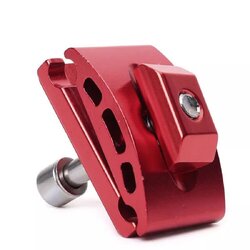I recently replaced my bike saddle. The fixing is shown in the attached photo. I found that it would not stay tightened once I began riding, and would work loose within a minute or two. I could see nothing wrong. I took it apart and re-set it in place, which seemed to work for a while but after a week or so it began working loose again. Today the bolt sheared off while I was riding. This happened to me on a different bike a few years ago. I'm not heavy. What might I be doing wrong to make this happen, and how might I ensure it doesn't recur?
View attachment 714257
The bolt didn't shear. It broke off from a stress crack that developed at the root of one of the exposed threads on the bolts in an area between the start of threads just after the smooth, unthreaded part of the bolt and where the threads in the nut (red aluminium nut) starts.
It is important to not use the term shear loosely, if you want to understand the mechanism of these breaks. Imagine you have a peeled banana. Now grip it with both hands so that your fists are touching each other. Now push the right fist away from you (keeping it parallel to the other fist) and simultaneously pulling the left fist towards you, keeping it parallel to the right fist. That is a shearing action. You can also do a torsional shear by rotating a fist or both fists in opposite directions.
What happened here is not shearing. A single-bolt seat clamp like this, with two wide clamshells holding the seat rails captive, develop a prying action as you move around on the seat and force the seat nose up and down. This prying action bends the bolt backwards and forwards. A crack develops at the weakest spot (the sharp root of the thread) and develops inwards, breaking the bolt.
It is a design problem easily avoided with a two-bolt design that eliminates the bending of a single bolt in the centre of the see-saw and transfers the flex to the seat rails instead, which have no weak stress risers and take the flex over a longer distance.



